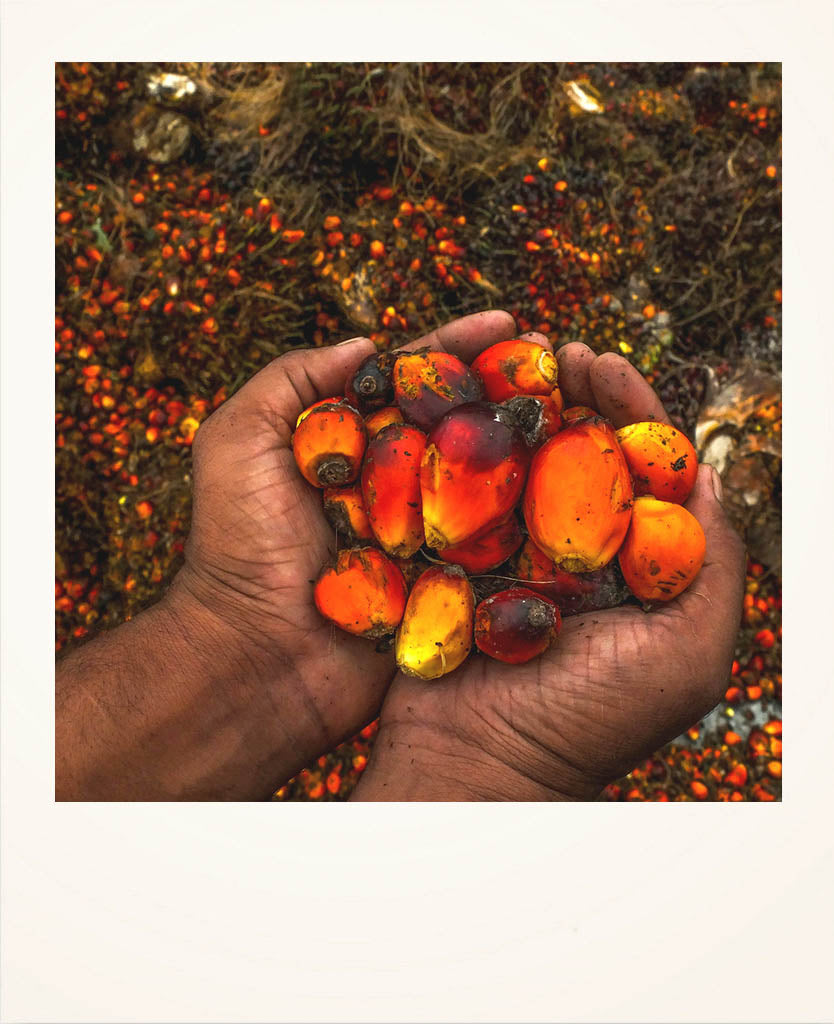If we showed you the list of ingredients in your favorite cookies right now and you read: And laeis guineensis , What would come to your mind? Unless you're in the scientific field or very knowledgeable about these topics, chances are nothing will come to mind and all of this will sound like gibberish to you. But what if we told you about palm oil? That would sound a little more familiar, right? Well, this strange name is nothing more than the scientific name that many brands use to refer to the most controversial vegetable oil of all, and by the way, a subtle way to deceive the average consumer.
As you well know, palm oil does not have a good reputation and there are more and more voices attacking it, but How is it possible that, despite so much information, global palm oil production has increased from 15 million tons in 1995 to 66 million in 2017? Today we delve a little deeper into this topic and tell you why it's necessary for us all to make and demand real change now.
What is palm oil?
Palm oil and its derivatives are obtained from the fruit of the species Elaeis guineensis , a species of palm native to West Africa, is known as the African oil palm. Despite archaeological evidence of its use dating back to 3000 BC, It was during the British Industrial Revolution that the first significant demand for this oil arose. and which began to be imported to Europe to be marketed as candles and machinery lubricant. It quickly became a highly prized commodity. not only because of its price, but because of its versatility . As demand increased in the 20th century, European-run plantations were established in Central Africa and were also widely introduced into Southeast Asia.

This versatility is directly related to its melting point , which allows it to remain solid at room temperature and maintains a silky, creamy texture at all times. So much so that today it has become a key ingredient in the production of processed foods : it remains solid, maintains the product's shape, and melts pleasantly when placed in the mouth. It is used liberally in confectionery and is generally used as the coating for chocolates, bonbons, and other sweets.
In addition to having a neutral taste and smell, it is an ingredient that offers a lot of possibilities in the food industry : it can be used to achieve certain textures such as the creaminess of margarines or the crunchiness of snacks. “ The food industry has not discovered any other vegetable fat like palm oil. that it is naturally solid at room temperature, with its availability and stability” ( La Vanguardia ). For these and many more reasons, Palm oil has become the second most widely produced type of oil, after soybean oil.
Although it is not marketed as a product in supermarkets, palm oil is not only the most widely used oil in food, but Its use is also widespread in skin care routines. Due to its low price and its anti-aging, cleansing, and moisturizing properties, it is the most common ingredient in numerous cosmetic products: creams, soaps, lotions, toothpastes, shower gels, sunscreens, etc.
So far, everything seems normal. It is a vegetable oil with versatile qualities and, on top of that, it is economical.
But then, Why has it become the great enemy of the 21st century?
Dr. Marion Nestle, one of the most influential people in the world of food, explains: “ Palm oil poses two major problems. First, Their high levels of saturated fatty acids increase the risk of coronary heart disease and secondly, Its production is highly harmful to the environment, as well as to human health .”
In a report published by the WHO entitled “ The palm oil industry and non-communicable diseases” Published in January 2019, it analyzes how The palm oil industry is promoting obesity and chronic diseases. “ This analysis illustrates many parallels with the nature of the practices adopted by the alcohol and tobacco industries,” the doctor summarizes.
Palm oil is a fat especially rich in saturated fatty acids, which are directly linked to the increase in various metabolic diseases. A bad fat, let's go. Surely this is not the first time you have heard the term fat. ' bad ' compared to 'good ' , but what exactly does that mean? Usually, fats ' bad ' correspond to those that have the biochemical profile of saturated fats, and ' hello good ' to the rest. But not all saturated fats are the same: there are also fats ' hello good ' within saturated fats. That being said, “ One of the suspects on the podium of the worst saturated fats is palmitic acid.” ( The Comidista ).
As if that were not enough, a study conducted by American scientists warned that retinyl palmitate (a chemical compound formed from the reaction between retinol and palmitic acid, and often used in the composition of cosmetic products) can accelerate the development of skin tumors and lesions when applied under sun exposure ( Due to the climate ).
Its environmental effect
One of the main consequences of palm oil production It is undoubtedly deforestation. Global demand is so great that huge areas of tropical forests and peatlands are being cut down. (if you don't know what peat bogs are, here We've left you a link that may help you understand it) to make way for oil palm plantations. The United Nations Environment Programme ( UNEP ) even claims that plantations have been illegally created in protected natural areas, such as national parks.
All of this not only has a detrimental effect on the natural habitat, but also on the atmosphere, local wildlife, and humans. One of the biggest consequences of deforestation in fact, is the Loss of biodiversity : As a result of the strong impact these crops have on tropical areas, many forest-dwelling creatures are forced to move. Natural corridors are eliminated, hotspots are damaged, and species populations become isolated, hindering their reproduction and diminishing their genetic diversity.
Furthermore, the indiscriminate use of pesticides, traps, electric fences, and shooting animals that enter crops has also been very harmful. In 1900, there were about 315,000 orangutans; today, there are fewer than 50,000, isolated in small groups that could become extinct within a decade. To be exact, more than 6,000 orangutans die each year as a direct result of oil palm expansion. Other species include the Sumatran tiger, the Sumatran rhinoceros, the sun bear, the pygmy elephant, the clouded leopard, and the proboscis monkey.
In addition to deforestation and species extinction, The production of palm oil generates so much CO2 emission into the atmosphere as a result of burning trees and peat , that it ends up directly contributing to the acceleration of climate change. climate change and the air pollution.
It is also worth highlighting the aggressiveness of the African palm in the soil on which it is grown, as it tends to monopolize its nutrients and progressively impoverish it, a fact that in turn forces the displacement of indigenous communities from their lands (who, if they were to end up working on such crops, would be forced to do so in conditions of semi-slavery) ( For The Climate ).
What can we do to stop it?
Although it may seem contradictory, Stopping or banning palm oil production is not the answer. “ One of the arguments put forward by conservation organizations, including the Conservation International and the IUCN , is that Removing palm oil from the equation will not alter the growing demand for edible oils and biofuels ” ( ZooPortraits ). Because other oil crops have lower yields than oil palm, Replacing it would only exacerbate the problem, as producers would need more land. “ Other oil crops require up to nine times more land than palm oil, so replacing it with other crops would significantly increase the total land used to produce enough vegetable oil to meet global demand” ( Cinco Noticias ). In short: The enemy is not palm oil itself, but how it is grown.
The The Union of Concerned Scientists proposes four steps to achieve a reform that will lead us to a solution to this problem:
- Plantation developers should improve yields and plant on degraded lands.
- Governments should shape their biofuel policies to avoid unintended consequences and ensure critical climate goals are met.
- That companies involved in palm oil businesses act to ensure that none of their raw materials contribute to tropical deforestation or peatland depletion.
- Let consumers exert their influence
Can I trust sustainable palm oil?
Sustainable Palm Oil (RSPO) aims to mark a gap with a past with more shadows than lights. And that's all very well, but what exactly is sustainable palm oil? Sustainable palm oil is any oil produced in an environmentally friendly manner and, due to its low environmental impact and quality controls, is designated as such. To say that it's sustainable means that it upholds a balance between respect for the planet's green lungs, the demands of the local population, and the animal diversity of ecosystems, respecting and protecting species like the orangutan.
They exist Symbols that can help us identify palm oil that has been produced in a socially and environmentally responsible manner as the RSPO and GreenPalm trade programs do:

For the Spanish Foundation for Sustainable Palm Oil The social alarm is unjustified . This organization emphasizes that sustainable palm oil " It aims to reduce the impact of production on natural habitats and improve the conditions of workers and indigenous communities ." Horacio González, an advisor to the Foundation, offers self-criticism: “ Yes, there have been inappropriate practices in the past, but that was precisely one of the reasons why sustainable palm oil emerged in collaboration with national governments, NGOs, and companies.”
What solutions are within our reach?
Market trends indicate that More and more consumers are paying attention to the fine print on the label to see if the desired product contains palm oil or not. Even brands that have eliminated it from their production process they advertise it in a prominent place next to the logo as a new brand value.
For those who wish to completely boycott products containing palm oil, we recommend making an informed decision before taking the plunge. The fact that words ' palm oil ' not appear on the package does not mean it is not there in one form or another. The label may say ' vegetable oil ' either ' vegetable fat ' and that may still be camouflaged palm oil. Luckily, there are many lists on the Internet that compile all these scams and They tell us how we can avoid them. We leave you one list of ingredients that WWF published with more than 20 terms that can help you make an informed decision when making your purchase.
Many brands have taken action on the issue. Nocilla, Trapa, and Nutriben, and supermarket private labels such as Alcampo, Aldi, and Mercadona, have abandoned palm oil in some of their products, opting for alternatives such as hydrogenated oils, coconut butter, sunflower oil, and cocoa butter. More expensive ingredients for large-scale production, but more sustainable and respectful of new consumers who demand change.
The most important thing now is to be informed and take action : either by choosing to consume sustainable palm oil or by avoiding the purchase of products containing palm oil. What matters is to stop contributing to the indiscriminate destruction of forests, their biodiversity and their communities , and the consequent pollution that is causing the production of this oil. Whatever the cause.



